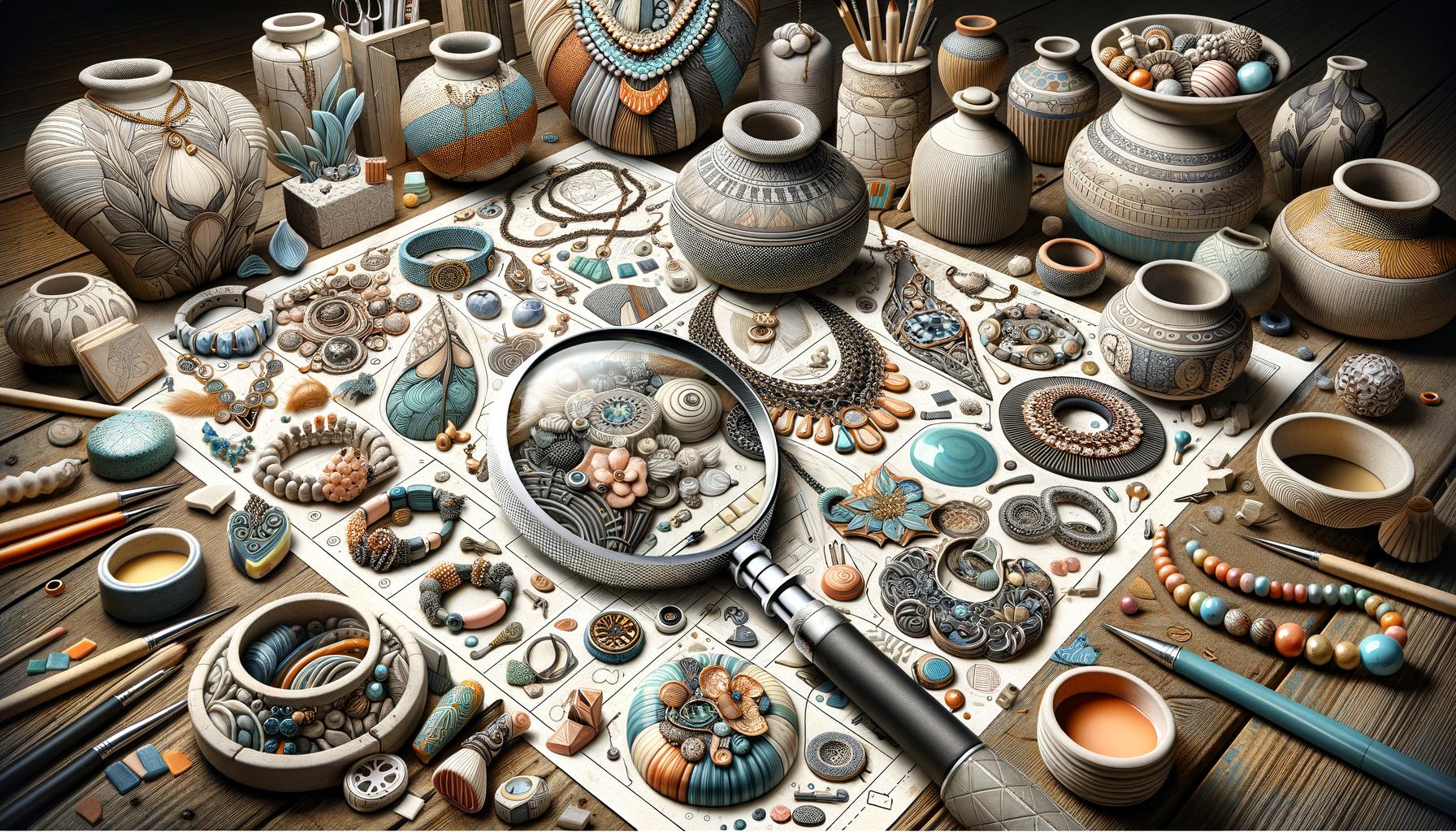In recent years, exploring the use of ceramic in modern jewelry design has become an exciting avenue for both artists and consumers. Ceramics, once largely confined to fine arts and functional pottery, are now making a bold statement in the world of contemporary jewelry.
This resurgence isn’t without historical precedent; ceramics have held a place in ornamental design as far back as ancient civilizations, including Egyptian faience amulets and Chinese porcelain ornaments. Today, we witness a revival and transformation driven by innovation and a growing appreciation for sustainable materials.
The comeback of ceramic in modern jewelry can be attributed to its singular properties that marry practicality with aesthetic allure. Designers are increasingly drawn to ceramic’s lightweight structure, durability, and remarkable versatility-a canvas upon which creativity knows no bounds. Unlike traditional materials like gold or silver, ceramics offer endless possibilities for achieving unique textures, colors, and finishes. From sleek minimalist pieces to elaborate statement items, ceramic proves an ideal medium for contemporary designs eager to break convention.
This article will delve into various facets contributing to the rebirth of ceramic jewelry. We’ll explore its intrinsic qualities that set it apart from more well-known materials and look at technological advancements facilitating this trend.
Additionally, we’ll discuss artistic endeavors pushing the boundaries of what ceramic can achieve aesthetically while also considering its environmental benefits compared to conventional precious metals. As we examine these elements, it’ll become clear why ceramics have earned their place in modern jewelry collections globally.
The Unique Properties of Ceramic Material
Ceramic is experiencing a renaissance in the world of modern jewelry design, primarily due to its unique properties that set it apart from traditional materials. Composed of non-metallic and inorganic compounds, ceramic is fashioned through high-temperature firing processes that result in an exceptionally strong and durable material. There are various types of ceramics used in jewelry making, including porcelain, earthenware, and stoneware, each offering distinct characteristics that provide designers with a broad palette for creativity.
One of the key features that make ceramic ideal for jewelry is its durability. Unlike metals which can scratch or tarnish over time, ceramic maintains its appearance even after prolonged wear.
Moreover, ceramic’s lightweight nature makes it particularly comfortable for everyday accessories such as earrings and rings. The material’s versatility enables artisans to produce a wide range of textures and finishes-from glossy and smooth to matte and rough-allowing for endless artistic possibilities when exploring the use of ceramic in modern jewelry design.
When compared to conventional materials like gold, silver, and gemstones, ceramic stands out not just for its robustness but also for its hypoallergenic properties. Many consumers who have sensitivities or allergies to metal find ceramic jewelry an excellent alternative since it does not cause skin irritation.
Furthermore, ceramics can be produced in a spectrum of colors through the incorporation of various pigments during manufacturing. This capability opens up new avenues for designers seeking vibrant hues without resorting to expensive or environmentally taxing metals.
| Property | Description |
|---|---|
| Durability | Resistant to scratching and maintains appearance over time |
| Lightweight | Comfortable for everyday wear such as earrings and rings |
| Hypoallergenic | Ideal for those with metal sensitivities or allergies |
| Color Versatility | Able to incorporate pigments allowing for a spectrum of colors |
These attributes collectively contribute to the growing popularity and continued exploration of ceramic’s potential in contemporary jewelry design. As both aesthetic preferences shift towards more diverse materials and technological advancements evolve the craft further, the role of ceramics in modern adornments seems set only to expand.
Technological Advances in Ceramic Jewelry Making
Modern technological advancements have revolutionized the process of crafting ceramic jewelry, bringing an unprecedented level of precision and creativity to the field. One of the most significant innovations is 3D printing, which allows designers to create intricate and highly detailed ceramic pieces that would be nearly impossible to achieve by hand. Utilizing computer-aided design (CAD) software, artists can meticulously plan every aspect of their designs before transferring them to a physical medium.
This digital-to-physical workflow ensures that each piece is a perfect representation of the artist’s vision. Exploring the use of ceramic in modern jewelry design has never been more exciting or accessible thanks to these technologies.
In addition to 3D printing, advancements in kiln technology and material science have also greatly enhanced the quality and durability of ceramic jewelry. High-temperature kilns enable precise control over firing conditions, reducing defects such as cracking or warping. Modern glazes and coatings have expanded the color palette available to designers while also providing improved resistance to wear and tear. As a result, today’s ceramic jewelry is not only more beautiful but also more practical for everyday use.
These technological advances do more than just improve quality; they open up new avenues for artistic expression. For example, combining traditional craftsmanship with digital techniques allows for a hybrid approach that leverages the benefits of both worlds.
Custom molds made from 3D-printed designs can be used alongside hand-finishing techniques to add unique textures and details, resulting in one-of-a-kind pieces that stand out in the marketplace. Furthermore, collaborative efforts between technologists and artists are pushing the boundaries of what is possible in ceramic jewelry design, continually inspiring new trends and innovations.
| Technology | Benefit |
|---|---|
| 3D Printing & CAD Software | Create intricate and detailed designs with high accuracy |
| Advanced Kiln Technology | Precise control over firing conditions reduces defects like cracking |
| Modern Glazes & Coatings | Expanded color options and improved durability |
Artistic Expression
Ceramic has become an unparalleled medium for artistic expression in the realm of modern jewelry design. Artists and designers are drawn to its versatility, enabling them to craft striking, intricate designs that resonate with contemporary aesthetics. Ceramics provide a blank canvas where creativity knows no bounds. Whether through hand-sculpting techniques or advanced digital modeling, the potential to create unique, one-of-a-kind pieces is virtually limitless.
Several aesthetically innovative ceramic jewelry pieces serve as prime examples of this artistic freedom. For instance, delicate porcelain earrings may feature fine hand-painted details inspired by traditional Asian motifs or abstract modern art.
Bracelets can incorporate textured surfaces and metallic glazes that catch light in captivating ways. The exploration of mixed media in pieces, such as embedding semi-precious stones or metals into ceramic bases, lends a tactile and visual complexity that is highly prized among trendsetters and connoisseurs alike.
The influence of various art movements also plays a significant role in modern ceramic jewelry design. Minimalist designers often employ clean lines and monochromatic palettes reminiscent of Bauhaus principles, while others draw from the vibrant colors and bold shapes associated with Pop Art.
Each piece becomes not only a fashion accessory but also a wearable piece of art. Exploring the use of ceramic in modern jewelry design thus opens up myriad avenues for personal expression and artistic innovation, paying homage to historical art forms while pushing the boundaries of traditional jewelry materials.
- Delicate porcelain earrings with hand-painted details
- Bracelets featuring textured surfaces and metallic glazes
- Combining semi-precious stones with ceramic bases
By integrating different artistic influences, contemporary designers have redefined what it means to wear ceramic as part of one’s personal style statement. This blend of history and forward-thinking creativity ensures that each piece tells its own story, making ceramics an appealing choice for both creators and consumers seeking originality in their adornments.
Sustainability and Ethical Considerations
Exploring the use of ceramic in modern jewelry design opens up significant conversations about sustainability and ethical considerations. As awareness around environmental conservation rises, consumers are increasingly drawn to materials that offer eco-friendly alternatives to traditional precious metals and gemstones. Ceramics stand out in this regard, primarily because they can be made from abundantly available natural resources like clay, which has a significantly lower environmental impact when compared to mining activities associated with gold, silver, or precious stones.
One of the primary environmental benefits of using ceramics in jewelry is that it does not require environmentally destructive mining processes. Traditional mining often leads to soil degradation, water pollution, and loss of biodiversity. In contrast, ceramics can be produced sustainably with minimal ecological footprint.
Moreover, modern advancements have enabled techniques such as heat recycling during firing processes and utilizing renewable energy sources, further reducing the carbon emissions associated with production. Many designers embracing this material highlight these green credentials as part of their brand ethos.
Furthermore, ethical sourcing is another major consideration where ceramic outweighs other materials traditionally used in jewelry making. Mining for precious metals and gemstones often raises concerns regarding poor labor practices and exploitative conditions in developing countries. In comparison, ceramics can be locally sourced and produced under fair working conditions more easily regulated within the country of production. Sustainable production methods can also include reusing waste materials from other industries (like construction) to craft ceramic base components for jewelry pieces.
| Comparison | Traditional Precious Metals vs Ceramics |
|---|---|
| Environmental Impact | High (due to mining) |
| Sourcing Ethicality | Often unethical due to exploitative labor practices |
| Ceramic Jewelry Impact | Low (sustainable production) / High ethics (fair working conditions) |
Advocates of ceramic jewelry also point out the potential for closed-loop systems where recycled or upcycled ceramics provide raw material for new pieces-an opportunity less feasible for most metal-based products without complex refinement processes. This focus on sustainability does not sacrifice creativity; rather it sparks innovation among designers committed to producing beautiful yet responsibly made adornments.
Versatility in Design and Style
Range of Styles From Minimalist to Elaborate
Exploring the use of ceramic in modern jewelry design opens up an astonishing range of aesthetic possibilities. Representing both minimalism and elaboration, ceramic jewelry can cater to a wide array of tastes and preferences. On one end, we see lightweight, unadorned pieces with clean lines that appeal to those who appreciate understated elegance. These minimalist designs often rely on the inherent beauty of the ceramic material itself, emphasizing sleek forms and subtle textures.
On the opposite side of the spectrum, elaborate ceramic jewelry incorporates rich colors, intricate patterns, and detailed craftsmanship. Advanced techniques such as glazing and hand-painting allow designers to produce complex designs that can rival those made from traditional materials like gold or platinum. This adaptability makes ceramic an appealing option for both daily wear and special occasions.
Incorporation With Other Materials
Ceramic’s versatility is further highlighted through its compatibility with other materials such as metals, wood, and glass. Combining ceramic elements with sterling silver or gold accents results in striking contrasts that enhance both materials’ visual appeal. Designers have also experimented with integrating wooden components to add warmth or using glass inserts for a touch of sophistication.
This multi-material approach not only adds depth to the pieces but also introduces unique textures that can’t be achieved using any single material alone. For consumers looking for something distinctive yet harmonious, these hybrid designs offer a plethora of creative possibilities.
Customization Options for Personalized Jewelry Pieces
Another exciting aspect when exploring the use of ceramic in modern jewelry design is its high customization potential. The malleable nature of ceramics before firing allows artisans to create uniquely personalized items tailored to individual tastes. Whether it’s incorporating specific color schemes, inscribing initials or messages, or shaping custom forms based on client specifications, ceramics offer unparalleled customization options.
For example, some designers use 3D printing technology alongside traditional handcrafting methods to achieve extraordinarily detailed personalization that would be difficult with more rigid materials like metal or gemstones. This kind of bespoke service has caught on rapidly among consumers looking for jewelry that resonates personally while still exuding artistic flair.
Market Trends and Consumer Preferences
The last decade has seen a significant shift in consumer preferences, particularly towards unique, personalized, and sustainable materials. Interestingly, exploring the use of ceramic in modern jewelry design has gained widespread appeal across diverse demographics. Consumers are increasingly drawn to the aesthetic versatility and ecological benefits that ceramic offers.
Current Trends in Ceramic Jewelry
Among current trends, minimalist designs are enjoying particular popularity. The simplicity and elegance of ceramic pieces resonate with consumers who prefer subtlety over ostentation. Meanwhile, vibrant colors and bold shapes cater to those who seek statement pieces that stand out.
Designers are experimenting with various hues and finishes, including matte textures and glossy sheens, to meet this diverse demand. Incorporating mixed-media techniques is also trending-ceramics paired with unconventional materials like reclaimed wood or recycled metals offer an edgy yet refined look.
Consumer Demand for Ceramic Pieces
Consumer demand for ceramic jewelry is on the rise due to its inherent qualities like durability, lightweight nature, and hypoallergenic properties. Additionally, the general public’s growing awareness of environmental sustainability has increased interest in ceramics as a viable alternative to traditional metals. The market has responded by introducing collections specifically targeting eco-conscious buyers who prioritize both style and ethical considerations.
Notable Designers and Brands Leading the Trend
Several designers and brands have cemented themselves as pioneers in the ceramic jewelry arena. For example, companies like 22 Design Studio are renowned for combining concrete-a form of ceramic-like material-with silver to create contemporary masterpieces.
Other notable names include Boo+Boo Factory, which specializes in colorful geometric forms, effortlessly blending wearability with artistic flair. These trendsetters continue to push boundaries, inspiring a new generation of designers looking to make their mark by exploring the use of ceramic in modern jewelry design.
Care and Maintenance of Ceramic Jewelry
To prevent damage, proper storage is equally important. Storing ceramic jewelry separately from other pieces avoids potential contact with harder materials that could cause chipping or scratches. Consider using padded compartments or fabric-lined boxes tailored specifically for this purpose. Keeping ceramics away from extreme temperatures and direct sunlight can also help maintain their color integrity and structural strength over time.
Addressing common concerns about fragility, it’s worth noting that modern ceramic technologies have significantly enhanced the resilience of these materials. However, accidents do happen.
In case of minor damage or chipping, some pieces might be repairable by professional jewelers specializing in ceramic work; they use specialized adhesives and techniques appropriate for the material. Exploring the use of ceramic in modern jewelry design reveals how innovative these advancements are, yet recognizing the need for gentle handling can further ensure your investment stands the test of time.
- Regular cleaning with mild soap and warm water
- Soft cloths or brushes to avoid scratching intricate designs
- Separate storage away from harder materials
- Avoiding extreme temperatures and direct sunlight
- Professional repair options available for minor damages
Case Studies
One remarkable example of ceramic jewelry that has made significant waves in the industry is the Kyocera’s “Cerinity” collection. This collection showcases the seamless blending of traditional craftsmanship with modern technology.
Each piece within the Cerinity lineup demonstrates an eye for precision and an inclination toward elegance, highlighting how exploring the use of ceramic in modern jewelry design can yield stunning results. The collection features artfully crafted rings, pendants, and bracelets that take advantage of ceramic’s unique ability to hold intricate shapes while maintaining a luxurious gloss.
In addition to Kyocera’s achievements, another noteworthy case study is found in the works of designer Carolina Bucci, who has also ventured into ceramics with her distinctive blend of aesthetic sensibility and innovative techniques. Her jewelry often incorporates ceramic beads combined with precious metals like gold and silver, resulting in pieces that are both visually striking and texturally harmonious.
These hybrid designs celebrate the versatility inherent in ceramics, making it clear why this material is gaining popularity among contemporary jewelers.
Moreover, consider Radà’s avant-garde approach to ceramic necklaces, which often feature asymmetrical designs influenced by abstract art movements such as Cubism and Dadaism. By integrating unexpected elements like semi-precious stones or even found objects into their pieces, Radà pushes the boundaries of traditional jewelry design while paying homage to artistic experimentation. This boldness exemplifies how ceramics provide a flexible medium for artists seeking to express intricate visions through wearable art.
Conclusion
Sustainability and Ethical Considerations
As the world becomes increasingly conscious of environmental and ethical issues, exploring the use of ceramic in modern jewelry design gains importance. Unlike traditional precious metals and gemstones, ceramics boast a smaller ecological footprint due to their abundant availability and less intensive extraction processes. The production methods for ceramics often involve lower emissions and wastewater compared to metal mining and gemstone excavation. Hence, consumers keen on reducing their environmental impact can look towards ceramic jewelry as a more sustainable alternative.
In addition to its eco-friendliness, ceramic jewelry also aligns with growing trends in ethical sourcing. Many jewelers are now committed to using materials that are responsibly sourced, ensuring that their supply chains do not exploit labor or degrade ecosystems.
This focus on conscientious consumption is making ceramic an attractive option for those who value transparency and sustainability in their fashion choices. Furthermore, artisans can incorporate recycled ceramics into their designs, adding another layer of environmental responsibility to the creation process.
Technological Advances Enhancing Creativity
The resurgence of ceramics in contemporary jewelry design has been significantly bolstered by technological advancements. Tools such as 3D printing and computer-aided design (CAD) have revolutionized how designers work with ceramic materials. These technologies allow for unprecedented precision and complexity in creating jewelry pieces, opening up new possibilities for artistic expression within the medium. Designers can experiment with intricate patterns and structures that were previously challenging or impossible to achieve through traditional crafting techniques.
Moreover, these technological innovations facilitate greater customization options for personalized jewelry pieces, accommodating unique consumer preferences. For example, CAD enables designers to readily alter variables like size, texture, and pattern before the actual production begins. This adaptability ensures that each piece can be tailored to meet individual tastes without compromising on quality or craftsmanship.
Artistic Expression: Ceramics as a Canvas
Ceramic’s inherent versatility serves as a blank canvas for jewelers seeking to push creative boundaries. Exploring the use of ceramic in modern jewelry design reveals how artists leverage this material’s distinct qualities-such as its ability to hold vibrant colors and create varied textures-to produce captivating works of wearable art. Leading designers draw inspiration from diverse art movements ranging from Art Deco’s geometric forms to organic motifs found in nature-inspired trends.
For example, innovative pieces often integrate other materials like precious metals or wood into ceramic bases, resulting in striking contrasts that enhance the overall aesthetic appeal. These combinations are not just visually appealing; they add layers of meaning and functionality to the jewelry. Whether it’s a minimalist pendant accentuated by subtle metal details or an elaborate statement necklace featuring blended mediums, ceramic offers limitless possibilities for creative exploration.
In celebrating these artistic endeavors, consumers are increasingly drawn towards unique and expressive pieces that stand out from conventional metallic counterparts. This shift is evident in market trends showcasing an upswing in demand for custom-designed ceramics that reflect personal style while maintaining a distinct identity within the broader landscape of contemporary jewelry design.
Resources for Further Exploration
The exploration of ceramic in modern jewelry design marks a significant evolution in the industry, intertwining tradition with contemporary innovation. This reemergence is more than just a revival of an ancient material; it represents a harmonious blend of art, technology, and sustainability that addresses both aesthetic desires and ethical considerations.
As we have discussed, ceramics have unique properties such as durability, lightweight nature, and versatility, which make them particularly suited for a wide range of jewelry styles and applications. These attributes set ceramics apart from traditional materials like gold and silver while offering fresh opportunities for artistic expression.
Advancements in technology have played a pivotal role in this transformation. The use of 3D printing and computer-aided design (CAD) allows for unparalleled precision and creativity in crafting ceramic pieces.
These innovations enable designers to push the boundaries of what’s possible, creating intricate designs that were once unimaginable. The combination of these advanced techniques with the raw beauty of ceramic material opens up new frontiers for both established artists and emerging designers seeking to leave their mark on the jewelry world.
Looking forward, the trend toward sustainability will likely drive further interest in ceramic jewelry. As consumers become increasingly environmentally conscious, the appeal of ethically sourced materials and sustainable production methods stands out.
Ceramic offers a lower environmental impact compared to traditional precious metals and gemstones, aligning perfectly with contemporary values. With notable designers leading this wave and consumer preferences continually gravitating towards innovative yet eco-friendly options, it is clear that ceramics are poised to become a mainstay in modern jewelry design.
In summation, ceramic’s storied past combines elegantly with technological prowess to shape an exciting future for jewelry making. This resilient yet adaptable material holds immense potential for continued innovation within the industry. As we keep exploring the use of ceramic in modern jewelry design, one can only anticipate its growing influence not just as an alternative but as a cornerstone material that reflects a fusion of historical reverence with forward-thinking creativity.
Frequently Asked Questions
How Is Ceramic Used in Jewelry?
Ceramic is used in jewelry due to its versatility, durability, and unique aesthetic appeal. Artisans craft ceramic beads, pendants, and rings that exhibit vibrant colors and intricate designs.
The material’s lightweight nature makes it comfortable for everyday wear. Additionally, ceramics can be coated with metallic finishes or embedded with precious stones to create elegant pieces that stand out in the fashion world.
What Is the Use of Ceramic in Interior Design?
In interior design, ceramics play a crucial role in creating both functional and decorative elements within a space. They are commonly used for tiling floors and walls due to their resilience against moisture and wear.
Ceramic tiles come in a plethora of colors, patterns, and textures, allowing interior designers to tailor spaces to specific themes or moods. Beyond tiling, ceramics are also employed in accessories like vases, pottery, and sculptures that add artistic flair and personality to home decor.
Why Is Ceramic Jewelry So Expensive?
Ceramic jewelry tends to be expensive because of the labor-intensive process involved in its creation and the high-quality materials used. Crafting ceramic pieces requires precision as artisans manipulate the clay, fire it at high temperatures in kilns, and often hand-paint or glaze each item meticulously.
The durability of ceramic means these pieces can last generations if properly cared for, adding intrinsic value over time. Additionally, limited production runs by skilled craftsmen often make ceramic jewelry unique or custom-made—an attribute highly prized by collectors and fashion lovers alike.

Welcome to my jewelry blog! My name is Sarah and I am the owner of this blog.
I love making jewelry and sharing my creations with others.
So whether you’re someone who loves wearing jewelry yourself or simply enjoys learning about it, be sure to check out my blog for insightful posts on everything related to this exciting topic!





